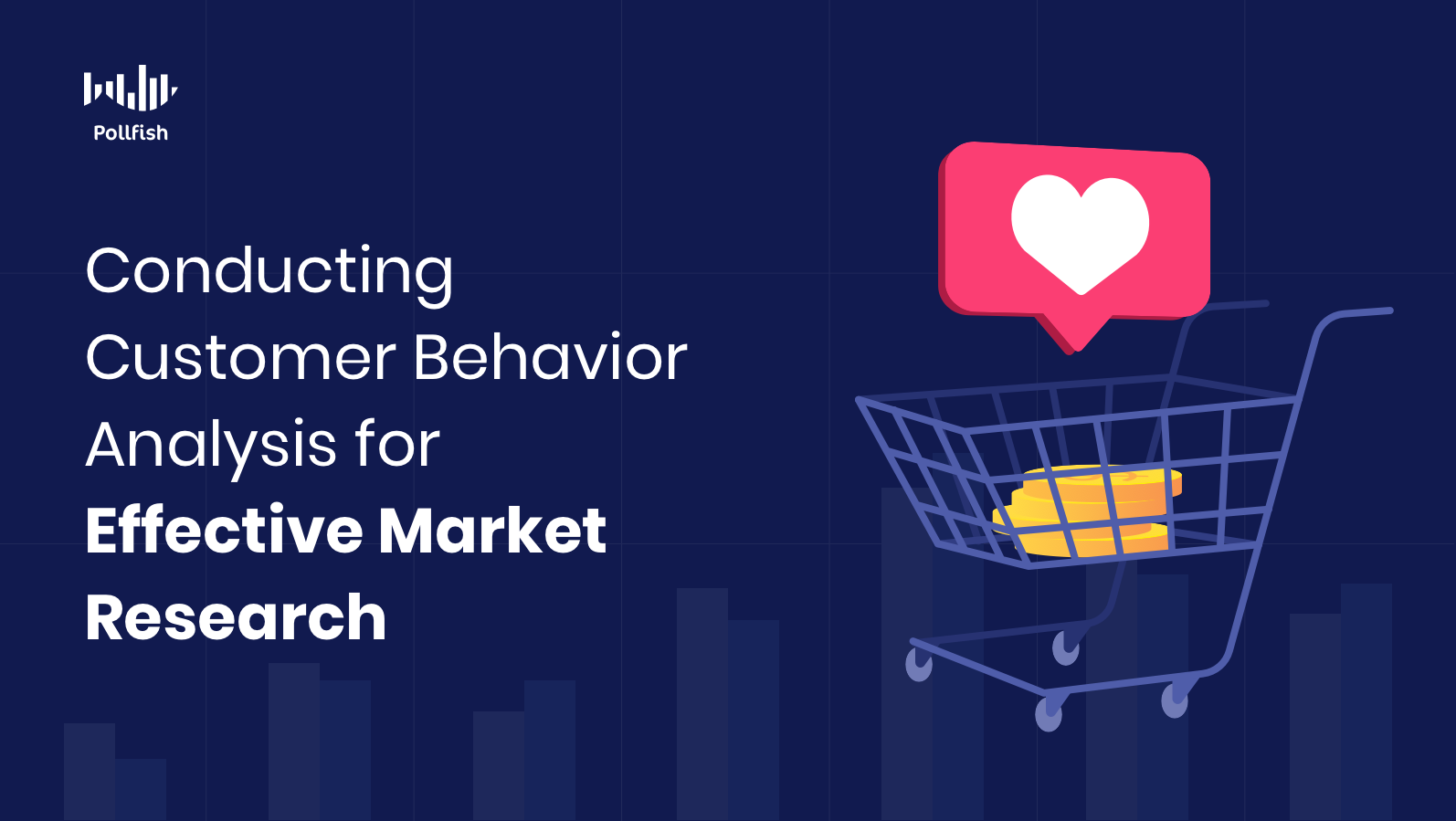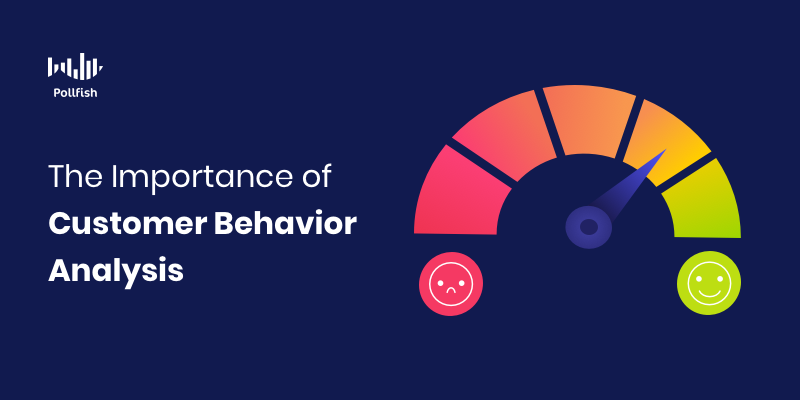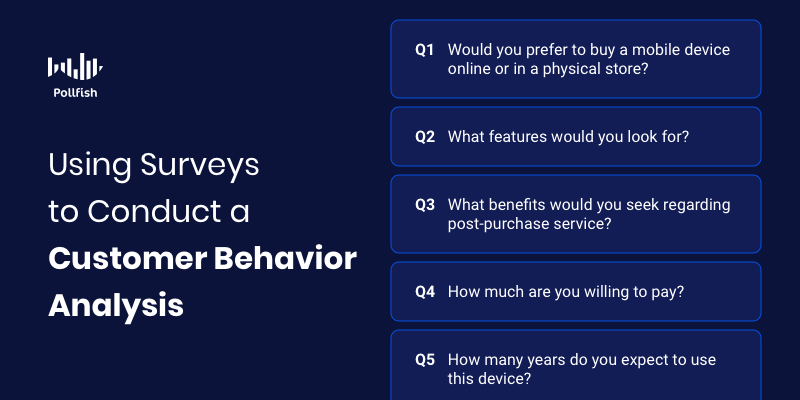Performing a Customer Behavior Analysis for a Deep Read

In order to access customers, businesses must conduct a customer behavior analysis. Given that customers are the lifeblood of any business, it is critical to analyze their behavior, as doing so will support any business strategy.
A customer behavior analysis is a kind of analysis that provides a granular evaluation of customer behavior. Specifically, it examines customer behavior in relation to a particular business.
It is especially important to run this analysis, given that customer expectations and needs constantly shift; nevertheless, 76% of customers expect companies to understand their needs. When businesses understand customer behavior, they have a context to their customers’ needs, making them more practical to fulfill.
This article explores customer behavior analysis, its importance, how to conduct it and how the role of survey research in conducting this analysis.
Understanding Customer Behavior Analysis
A customer behavior analysis is a kind of analysis that melds qualitative and quantitative observations of how customers interact with a particular company. It involves studying how customers interact in-store, on a website, social media, apps and other places, both physical and digital.
This analysis examines what influences their customer buying behavior, which includes studying the triggers, motivations and reasons behind their buying choices.
In this behavior analysis, customers are first segmented into customer personas based on their shared characteristics. Then, researchers observe each segment throughout the different stages of their customer journey map. This stage serves as the heart of the analysis, as it requires scrutinizing how the personas interact with a company.
This analysis grants insight into the various variables that may influence a customer segment and customer persona. It allows businesses to understand how customers feel about a company, thus it is a crucial component of brand tracking.
The Importance of Customer Behavior Analysis

It is important to conduct customer behavior analysis for a number of reasons.
A behavior analysis is a proven method for understanding customers and connecting them to the business. It allows businesses to understand their customers’ priorities, motives and rationalizations behind their decisions.
Given that customers exhibit these thoughts and actions as part of the customer journey, conducting this kind of analysis helps businesses understand how customers feel about their company.
Additionally, a customer behavior analysis allows companies to understand customer habits and motivations. This includes how customers behave in different settings, whether it is digitally or physically.
Without it, market researchers and online store web developers would only have a scant idea of how their customers shop, whether it is on or offline. Conducting it can reveal these multi-environmental habits, also revealing unique or latent patterns.
Businesses can also offer a better shopping experience by nailing down where and how customers face issues. These can involve non-virtual problems, such as poor customer support, along with technical problems, such as slow web pages and functionality problems.
When it comes to the latter, a poor check-out experience may lead customers to abandon their carts prior to purchasing. Additionally, an improper search may deter shoppers from finding their products. These instances lead to site leaves and lack of conversions, therefore casting a blow to revenue. Businesses can avoid these issues and missed opportunities by performing a customer behavior analysis.
Furthermore, businesses can improve their existing marketing campaigns and form new ones from analyzing customer behavior. This will improve both customer retention and acquisition, as brands can tweak campaigns based on studying existing target market members, therefore creating more fitting campaigns for future potential customers.
This analysis reveals recurring patterns on shopping transaction timing, location of purchase, device used for purchases, frequency of buying, favorite products and other behavioral aspects. As such, marketers can better understand customers’ actions and use this information to target their audience more precisely.
Moreover, marketers can use this data to optimize various customer experiences, create more personalized content from the intelligence they gained, create more enticing advertising campaigns and determine the value of different customer segments and personas.
All in all, customer behavior analysis offers a myriad of benefits that can help solve various business needs.
The Use of Surveys in Customer Behavior Analysis

Given the scope of customer behavior, there are various methods and tools to analyze it, from one-on-one calls with customers, to in-store experiences, to digital tools such as experience analytics.
Online surveys are the most potent tool for studying customer behavior, as they allow businesses to study virtually any aspect of customer behavior and ask all of their desired questions.
Surveys offer value in various aspects of performing a customer behavior analysis, such as segmenting customers via market segmentation. This allows businesses to understand the key groups making up their target market and how to serve them more effectively. Additionally, as aforementioned, surveys help businesses form their customer personas, another key practice for targeting an audience.
Surveys allow market researchers to inquire into any customer behavior topic. This way, researchers can detect the presence of certain common behaviors, along with patterns in preferences, actions and inclinations, all of which are crucial factors in a behavioral analysis.
Surveys can provide both qualitative and quantitative market research data for researchers, granting them a holistic view of customer behavior. Thus, surveys do not merely provide a means of analysis but are complementary to various market research campaigns.
A strong survey platform makes it possible and practical to study a vast pool of customer behavior via deployment across thousands of high-traffic websites and apps. Additionally, a platform that offers filtering data for survey results makes it easy to perform an analysis of all the collected data.
How to Conduct a Customer Behavior Analysis
There are several ways to perform such an analysis, including through the use of surveys. The following explains how to conduct a customer behavior analysis through a multi-step approach:
- Segment your target audience. This involves dividing your customers into various groups, or segments, based on shared demographic and psychographic characteristics.
- There is also a wide range of other characteristics to use for segmenting, involving behavioral characteristics such as:
- Web and app activity, preferred media channels and online and offline shopping habits.
- Consider the most valuable segments to your business. You can find them when you calculate customers’ CLV or customer lifetime value, or by performing an RFM analysis.
- There is also a wide range of other characteristics to use for segmenting, involving behavioral characteristics such as:
- Pinpoint the benefits of each segment. Each customer group and persona will choose a particular business in their own unique way. Market researchers should identify what triggers these segments to choose a particular company over another.
- Refer to products, services and experiences, along with external factors that influence buying decisions.
- Consider the different effects on purchasing, such as: did customers buy a product due to its brand? Did they make a convenience purchase? How much did the customer seek to spend? How urgent was their purchase decision?
- Always consider the context of a customer’s behavior and needs during the analysis.
- Conduct survey research. This involves using both the qualitative survey and quantitative survey for a holistic read of your customers’ behaviors.
- Additionally, it is critical to perform secondary market research, using external sources of already published data. While this provides useful information, not all or any secondary resource will provide relevant information to your niche and specifically, your customer base.
- After you conduct qualitative and quantitative research, compare the two sets against each other as you discover patterns, habits and other key components of customer behavior.
- Use your analysis findings on a campaign. You can apply your analysis to various campaigns, from content optimization to advertising.
- Use the best delivery channel for each persona.
- Provide personalization to different segments and personas whenever possible.
- Fix any hindrances in the CX (customer experience).
- Nurture the customers throughout their CX.
- Assure any changes won’t adversely affect your customers, as not all will be receptive to change. Conducting surveys can help you determine which customers are less fond of it.
- Analyze the results of any changes you’ve applied to your campaigns. Marketers should always test their results and the same applies to changes made after running a customer behavior analysis.
- Test the effects of your changes with different metrics such as traffic to websites. Advertising spend versus revenue, conversion rates, CLV, customer acquisition cost (CAC) and more.
- Analyzing results ought to be a continual process, giving the vast external influences on customers, such as politics, technology, new products in a niche, etc.
Staying Attuned to Customers
Performing a customer behavior analysis is a crucial task in obtaining a deep understanding of how customers behave in relation to your offerings, experiences and business as a whole. Such an analysis should therefore be ongoing, as even the most loyal customers change from various influences.
Surveys provide a powerful yet practical means for performing a behavioral analysis, given that they can be deployed to the masses, are highly targeted and allow market researchers to delve into any behavioral topic through questions of their choice.
The key is to use an online survey platform that offers these capabilities and more.
Although conducting such an analysis is likely to require several tools and methods, surveys allow researchers to capture insights into all customer behaviors, along with their needs and opinions, as surveys allow researchers to explore any topic and ask about it explicitly and in a custom way.
A strong online survey platform offers capabilities that put survey bias, survey fraud and other low-quality data at bay. Such a platform makes it easy to study customer behavior by extracting data based on precise demographics and psychographics, adding randomization to the sampling process via RDE (random device engagement) and offering several data visualization formats.
Businesses should therefore choose their online survey platform wisely.
Pollfish Marketing Team
Ready to Try Pollfish?
Create your survey with AI, target high-quality respondents starting at $0.95 per complete, and start getting results in just minutes in real-time. From running a simple product concept survey to managing a constant stream of trackers for dozens of clients in dozens of countries, we’ve got you.
